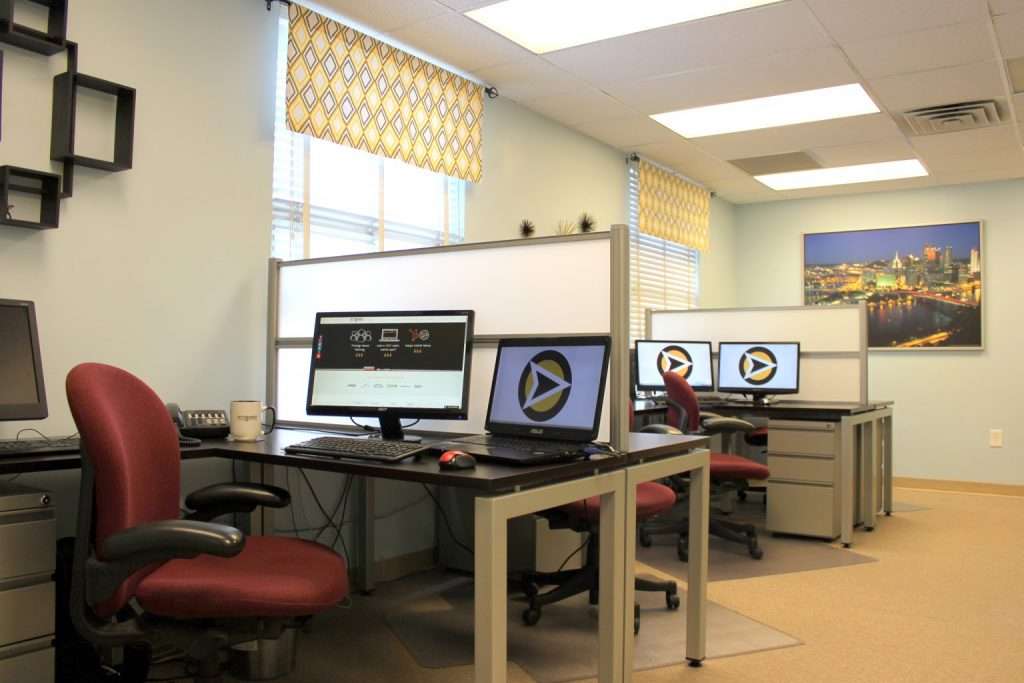Commercial vs. Corporate Moving: Service That Fits Your Needs
February 6, 2025
Moving a business is a significant endeavor, requiring careful planning and the right type of moving service to ensure a smooth transition. But what’s the difference between commercial moving and corporate moving, and which one best suits your business needs? Understanding the distinctions between these two services can help you make an informed decision that saves time, money, and stress.
Commercial moving involves relocating business assets, equipment, and office spaces. This type of move is commonly used by retail stores, warehouses, and small-to-medium-sized businesses that need to transport furniture, inventory, and operational tools. The process typically includes:
To get a better understanding of commercial moving services, check out this detailed guide on the commercial moving process.
Corporate moving, on the other hand, refers to relocating entire companies or assisting employees with work-related relocations. This type of move is often seen in large enterprises, government offices, and multinational corporations. Services may include:
One of the biggest challenges in corporate moving is the risk of disrupting business operations. If you’re planning an office move, make sure to follow these essential tips to move your office without disruptions.
| Aspect | Commercial Moving | Corporate Moving |
|---|---|---|
| Scope | Business assets and equipment | Entire business relocation, including employees |
| Common Clients | Retail stores, warehouses, small businesses | Large enterprises, multinational corporations |
| Services | Packing, transporting, IT handling | Employee relocation, large-scale logistics |
| Downtime | Short-term disruptions | Potential long-term impact |
Before selecting a moving company, you need to evaluate the specific needs of your business. Here are some key considerations:
If you’re a small business relocating office space, a commercial mover may be the best fit. However, for corporate relocations involving multiple employees and international moves, a corporate moving service would be more suitable.
Moving costs can vary depending on the complexity of the move. Understanding how moving companies charge for services can help you budget more effectively.
Corporate moves during peak seasons or holidays can be particularly challenging. Learn more about the unexpected difficulties of corporate moving during the holidays before making your decision.
Proper planning is key to minimizing delays and keeping your business operational. Be sure to check out this list of things to do before hiring commercial movers.
Choosing between commercial and corporate moving services depends on your business size, scope, and requirements. While commercial moving focuses on relocating assets and equipment, corporate moving covers a broader spectrum, including employee relocation and IT transfers. By assessing your specific business needs and planning ahead, you can ensure a seamless transition without unnecessary downtime or unexpected costs.
Looking for more insights on moving services? Explore the different types of moving companies and services available to find the perfect fit for your business relocation needs.
Relocating a business is a complex process that involves careful planning and budgeting. Whether you’re moving to a larger office space or relocating to a new city, understanding the factors that influence the cost of corporate moving services can help you manage expenses effectively. Below, we break down the key elements that impact pricing.
The distance between your current office and the new location significantly affects moving costs. Local moves tend to be more affordable than long-distance relocations, which may require additional fuel, labor, and logistical planning. Additionally, moving to urban centers with high traffic congestion can increase costs due to delays and restricted access.
The more office furniture, equipment, and supplies you need to move, the higher the cost. Moving companies charge based on the weight and volume of your belongings. Conducting an inventory assessment beforehand can help you determine what is essential to transport and what can be donated or sold.
There are various types of moving companies and services available, ranging from full-service movers to DIY rental options. Opting for a full-service moving company that handles packing, transportation, and unpacking will be more expensive than a basic transport-only service. Learn more about the different types of moving companies and moving services to find the best fit for your needs.
The timing of your corporate move plays a crucial role in pricing. Peak moving seasons, such as summer and early fall, typically come with higher rates due to increased demand. Additionally, relocating during holidays can present unexpected challenges. To avoid unnecessary expenses, be aware of the unsuspected difficulties of corporate moving during holidays and plan accordingly.
Minimizing business disruptions is a priority when moving an office. If a move interferes with operations, companies may face revenue loss. Hiring an experienced corporate moving service that specializes in seamless transitions can help you move your office without disrupting your business, ensuring productivity remains intact.
Extra services, such as packing, furniture assembly, IT setup, and storage solutions, can increase moving costs. If your business requires temporary storage before settling into the new location, this will add to the total expenses. Be sure to request a detailed estimate from your moving provider to understand any additional costs.
Corporate moving costs vary based on multiple factors, including distance, volume, service type, and timing. Proper planning, choosing the right movers, and minimizing downtime can help keep expenses under control. By understanding these cost factors, businesses can make informed decisions and ensure a smooth transition to their new location.
One of the most significant concerns for many is the cost associated with hiring moving services. By choosing the right day to move, you can save a substantial amount of money. In this blog post, we’ll explore how to strategize your move by discovering the most affordable day to hire moving services.</p>
Before diving into the best days to move, it’s essential to understand the various factors that influence moving costs. These include the distance of the move, the volume of items being moved, the type of moving service, and the time of year.
The day of the week can significantly impact the cost of moving services. Moving companies often charge higher rates on weekends and during peak times. By choosing a less popular day, you can save money without compromising on service quality.
1. Mid-Week Moves Moving in the middle of the week, such as Tuesday or Wednesday, is often the most cost-effective option. Most people prefer to move on weekends to avoid taking time off work, making mid-week moves less busy and more affordable.
2. Early or Late in the Month The beginning and end of the month are popular times for moving due to lease agreements ending and starting. Opting for a move in the middle of the month can result in lower rates and more availability from moving companies.
3. Off-Peak Seasons Moving during the off-peak seasons, typically fall and winter, can also lead to significant savings. Summer is the busiest moving season, with higher demand and prices. Consider planning your move for a quieter time of year to get the best rates.
4. Book in Advance Booking your moving services well in advance can secure lower rates and ensure availability. Last-minute bookings often come with higher prices due to limited availability.
5. Compare Quotes Don’t settle for the first moving company you find. Take the time to compare quotes from multiple companies to find the best deal. Websites like Top Local Movers can help you find reputable and affordable movers.
6. Be Flexible with Dates If you have flexibility with your moving date, you can take advantage of lower rates. Moving companies may offer discounts for less popular moving days or times.
7. Consider Eco-Friendly Options Eco-friendly moving services not only help the environment but can also be cost-effective. Check out eco-friendly moving services for sustainable and affordable moving options.
Understanding the different types of moving services available can also help you save money. For a comprehensive guide, visit Different Types of Moving Companies and Moving Services Explained.
8. Local Moves Local moves are typically less expensive than long-distance moves. For guidance on a stress-free local move, check out Local Movers: Your Guide to a Stress-Free Move.
9. Long-Distance Moves Long-distance moves require more planning and can be more expensive. However, by choosing the right day and following our tips, you can still find affordable options. For more information, read The Ultimate Guide to Long Distance Moving.
10. Reputation and Reviews Choosing a reputable moving company with positive reviews can save you money and prevent headaches. Look for companies that are transparent about their pricing and have a track record of excellent service.
11. Interstate Moving Companies If you’re planning an interstate move, it’s crucial to find a reliable company that offers competitive rates. Best Interstate Moving Companies provides insights into top-rated movers for your interstate relocation needs.
Strategizing your move by choosing the most affordable day to hire moving services can result in significant cost savings. By moving mid-week, during off-peak seasons, and booking in advance, you can find the best rates without compromising on service quality. Additionally, understanding the different types of moving services and being flexible with your dates can further reduce costs. For a comprehensive list of reputable moving companies and additional tips, explore the provided resources.
By planning ahead and considering these factors, you can hire moving services and make it as affordable and stress-free as possible.
Minimizing downtime during your corporate relocation is crucial to maintain productivity and ensure a smooth transition. In this guide, we will explore effective strategies to keep your business running efficiently throughout the move.
The first step in minimizing downtime is to set clear objectives for your corporate relocation. Define what you want to achieve, such as minimal disruption to daily operations and a swift transition to the new location. Having clear goals will help you stay focused and organized.
A well-structured timeline is essential for a successful move. Break down the relocation process into manageable tasks and set realistic deadlines for each phase. This will help you stay on track and ensure that all necessary preparations are completed on time.
Selecting a reliable commercial moving company is vital to minimize downtime. A professional mover can handle the logistics efficiently, allowing you to focus on other important aspects of the move.
When choosing a moving company, consider their experience, reputation, and the range of services they offer. For a comprehensive understanding of different moving services, check out this guide on different types of moving companies and services.
Transparent communication with your employees is crucial during a relocation. Keep them informed about the moving schedule, their roles, and what to expect. This will reduce anxiety and ensure everyone is on the same page.
Notify your clients and business partners about the move well in advance. Provide them with the new address and contact information, and assure them that your services will remain uninterrupted.
Before the move, ensure that the new office is fully prepared for your arrival. This includes verifying that all necessary utilities are set up and that the workspace is ready for use.
Technical issues can cause significant downtime. Make sure that the new location has the necessary infrastructure to support your IT systems and address any potential issues before the move.
Data loss can be catastrophic during a move. Ensure that all important data is backed up securely before your corporate relocation. This will safeguard your information and allow for a seamless transition.
Set up the IT infrastructure at the new location before the move. This includes installing servers, setting up networks, and ensuring that all systems are operational. Doing this in advance will minimize disruption to your business operations.
Efficient packing is essential for a smooth move. Use high-quality packing materials and label all boxes clearly. This will make unpacking easier and ensure that all items are accounted for.
Label each box with its contents and the designated location in the new office. This will help your team unpack efficiently and get settled in quickly.
Sensitive equipment, such as computers and servers, require special handling. Use appropriate packaging materials and ensure that these items are transported securely.
Security is a major concern during a move. Take necessary precautions to protect sensitive equipment and confidential information throughout the relocation process.
Relocation can be stressful for employees. Address their concerns by providing clear information and support. Consider offering relocation assistance to make the transition smoother for them.
Providing relocation assistance, such as help with finding housing or moving personal belongings, can ease the burden on your employees and ensure they are ready to work in the new location.
Effective coordination is key to a successful move. Work closely with your moving company to ensure that all logistics are handled efficiently and that the move is completed on schedule.
Safety and security should be top priorities during the move. Ensure that all items are transported securely and that the new location is safe for employees to return to work.
Set up the new office in a way that maximizes productivity. Arrange workspaces to suit the needs of your employees and ensure that all necessary equipment is in place.
Before resuming operations, test all equipment and systems to ensure they are functioning correctly. This will help you identify and resolve any issues before they impact your business.
Conduct a trial run of your business operations in the new location. This will help you identify any potential issues and ensure that everything is working as expected.
Use the trial run to identify and resolve any problems that arise. Addressing these issues before fully resuming operations will minimize downtime and disruptions.
After the move, take the time to evaluate the relocation process. Identify what went well and what could be improved for future moves.
Gather feedback from employees and stakeholders about the move. Their insights can help you improve your relocation strategy and ensure a smoother process in the future.
Even with the best planning, unexpected disruptions can occur. Have a business continuity plan in place to address any issues that arise and ensure minimal impact on your operations.
Your business continuity plan should focus on maintaining essential functions and minimizing the impact on your operations during and after the move.
Minimizing downtime during your corporate relocation is achievable with careful planning and effective execution. By setting clear objectives, communicating effectively, and preparing for potential issues, you can ensure a smooth transition and keep your business running efficiently.
Deciding between remodeling your current home or relocating to a new one is a significant decision that impacts finances, lifestyle, and the future. Both options have advantages and drawbacks, and the best choice can depend on individual circumstances, preferences, and long-term goals. This comprehensive comparison explores the key factors to consider when making this crucial decision.
Consider whether more space is needed due to a growing family or changing lifestyle. Assessing your current and future space requirements is essential in deciding whether to remodel or relocate.
Evaluate satisfaction with your current neighborhood and its amenities. A desirable location can influence the decision to stay and remodel.
Reflect on the emotional attachment to your current home and its memories. Emotional ties can make it more challenging to relocate.
Study and know your budget and the potential costs involved in each option. Understanding your financial capacity is crucial for making an informed decision.
Consider long-term plans and whether you intend to stay in the area for the foreseeable future. This can significantly impact the decision to remodel or relocate.
Remodeling can be a more cost-effective solution compared to purchasing a new home. Depending on the extent of the renovations, remodeling can provide the necessary upgrades without additional costs associated with moving, such as real estate commissions, closing costs, and moving expenses.
One significant benefit of remodeling is the ability to customize the home according to personal preferences. This allows you to choose the design, materials, and layout that best suit your needs, creating a perfect spot that reflects your personality and lifestyle.
Well-executed remodels can significantly increase the property’s value. Upgrades to critical areas such as the kitchen, bathrooms, and living spaces can yield a high return on investment, making the home more attractive to future buyers.
Remodeling avoids the stress and logistical challenges associated with relocating. Staying in a familiar environment can be more convenient and less disruptive to daily life.
Remodeling plans can be disruptive to daily life. Depending on the scope of the renovations, noise, dust, and limited reach to certain areas of the home may be issues. In some cases, temporary relocation may be necessary.
Renovation projects often incur unexpected costs due to unforeseen issues such as structural problems, outdated wiring, or plumbing complications. Having a contingency budget to cover these potential expenses is crucial.
There are limitations to what can be achieved through remodeling, especially if the home has structural constraints or zoning regulations. In some cases, relocating may be the only viable option to meet your needs.
Relocating to a new home offers a fresh start and an opportunity to find a property that better suits current needs and lifestyles. A home with the desired layout, size, and amenities can be chosen without the limitations of the current property.
Moving to a new neighborhood or city can provide access to better schools, healthcare facilities, recreational options, and other amenities that enhance the quality of life.
Newer homes often have modern features and energy-efficient systems that can reduce utility bills and improve comfort. Upgrading to a house with advanced technology and sustainable design can be a significant advantage.
Investing in a new home in a growing area can offer the potential for property value appreciation. Researching and choosing a location with strong growth prospects can provide long-term financial benefits.
Purchasing a new home involves significant upfront costs, including down payments, closing, and moving expenses. Additionally, there may be costs associated with selling the current house, such as real estate agent fees and necessary repairs or upgrades to make the home market-ready.
Leaving a home with memories can be emotionally challenging. Adjusting to a new and better environment, building new relationships, and settling into a different community can be stressful and time-consuming.
Real estate markets can be unpredictable, and finding the perfect home at the perfect price can be challenging. Market conditions can affect the availability and affordability of suitable properties, potentially delaying plans.
The logistics of moving can be complex, involving packing, coordinating with movers, and ensuring the safe transport of belongings. This process can be particularly daunting if you have a large family or valuable possessions.
When considering relocating, one of the critical aspects is the moving process itself. Three men and a truck services provide an efficient and reliable solution for those looking to move. The cost of moving services like these is often based on the distance of move, the volume of items, and additional services required. This option can streamline the moving process, reduce stress, and ensure that belongings are transported safely and efficiently. For detailed cost estimates and to understand the services better, it’s advisable to get a free quote or call (833) 642-1373.
Compare the estimated costs of remodeling your home versus purchasing a new one—factor in all expenses, including renovation costs, moving expenses, and potential increase in property value.
Assess how attached you are to your current home and neighborhood. Consider the emotional impact of leaving a familiar environment versus the excitement of starting fresh.
Research the real estate market in your area and the area you are considering moving to. Understanding the new market trends can help you make a financially sound decision.
Seek advices from real estate agents, contractors, and financial advisors to comprehensively understand your options. Professional insights can provide valuable guidance tailored to your specific situation.
Clearly define your priorities and long-term goals. Whether you choose to remodel or relocate, ensure that the decision aligns with your vision for the future.
The decision to remodel or relocate is deeply personal, influenced by financial considerations, lifestyle needs, and emotional attachments. By meticulously evaluating the advantages and drawbacks of each option and considering unique circumstances, an informed choice that best suits needs and goals can be made.
Whether your company is expanding, downsizing, or just looking for a change of scenery, the commercial moving process is something that many businesses will encounter at some point. Commercial moving is a complex and intricate task, but with the right guidance, it can be a smooth transition. In this article, we will explore the ins and outs of commercial moving, uncover the key steps involved, and offer valuable insights to help you navigate the process seamlessly.
Commercial moving involves the relocation of businesses from one location to another. This is a far cry from the typical residential move, as it encompasses various aspects that are unique to the business world. In essence, it’s not just about moving from point A to point B; it’s about ensuring that your business operations continue without significant disruptions. For businesses, time is money, and the seamless transition of assets and operations is of paramount importance.
Commercial moving is a mammoth task that requires professional expertise. This is where moving services come into play. These specialized services are provided by moving companies that are well-versed in the intricacies of commercial relocations. They understand the importance of minimizing downtime and keeping your business running smoothly.
Choosing the right commercial moving companies is a critical decision that can make or break your relocation experience. It’s essential to do your due diligence and research various moving companies before making a final decision. The key factors to consider when selecting commercial movers include their experience, reputation, insurance coverage, and the range of services they offer.
Commercial moving doesn’t happen overnight; it requires meticulous planning and preparation. This involves creating a comprehensive plan that outlines every step of the process. The plan should include a timeline, a budget, and a clear inventory of all items that need to be moved. Having a solid plan in place is the first step in ensuring a successful commercial move.
Mistakes in commercial moving can be costly. To help you steer clear of potential pitfalls, here are some valuable tips:
The first phase of commercial moving is an in-depth assessment of your current workspace. This includes taking stock of all equipment, furniture, and supplies. The planning phase involves determining the optimal layout for your new workspace and making decisions about the allocation of resources.
Packing and labeling are crucial steps in the commercial moving process. Professional moving companies provide specialized packing services to ensure that your assets are secure and organized during transport. Each item should be carefully labeled for easy identification at the new location.
Once everything is packed and labeled, the next step is transportation. This involves the physical move of your assets to the new location. You can choose from various transportation options, such as moving containers, which offer flexibility and security.
After arriving at the new location, it’s time to set up and install all the equipment and furniture. Your commercial movers will assist in this phase, ensuring that everything is arranged according to the plan.
In today’s digital age, technology plays a significant role in the commercial moving process. It’s not just about physical assets; it’s also about ensuring the seamless transition of your IT infrastructure. This includes moving servers, workstations, and other technology assets without causing disruptions to your business operations.
Before declaring the move a success, thorough testing and inspection are essential. This involves checking all equipment and ensuring that everything is in working order. It’s a critical step to avoid any surprises down the road.
Once the move is complete, it’s crucial to familiarize your employees with the new workspace. Employee orientation includes guiding them through the new layout, helping them settle into their new workstations, and addressing any questions or concerns.
Hiring commercial movers offers several advantages. Here are some of the key benefits:
In the world of business, change is inevitable, and when it comes to changing locations, the commercial moving process is a vital aspect of a company’s journey. From the initial assessment and planning to the final setup and employee orientation, commercial moving involves a series of well-orchestrated steps that require careful execution.
When embarking on a commercial move, it’s essential to partner with the right commercial moving companies to ensure a smooth transition. This decision, coupled with a well-thought-out plan, will pave the way for a successful relocation. By understanding the intricacies of the commercial moving process and avoiding common pitfalls, your business can continue to thrive in its new location.
Don’t hesitate to reach out to us at Wow Mover for expert guidance and assistance with your commercial move. Whether you are looking for the best interstate moving companies, top local movers, or the right moving containers, we have you covered. Your business’s success is our priority, and we are here to make your commercial move a seamless and stress-free experience.
One crucial aspect of planning a successful move is obtaining accurate and reliable moving estimates. In this comprehensive guide, we will walk you through everything you need to know about moving estimates, ensuring that you have the necessary information to make informed decisions and ultimately secure the best possible moving services.
When planning a move, it’s important to have a clear understanding of what goes into a moving estimate. A moving estimate is a detailed breakdown of the costs associated with your move, including various services and fees. By obtaining multiple moving estimates, you can compare prices, services, and terms to make an informed decision.
There are different types of moving estimates, and it’s essential to understand their distinctions:
Several factors contribute to the final cost of a moving estimate. Understanding these factors will help you make better decisions and anticipate potential expenses:
To obtain accurate moving estimates and ensure you are getting the best value for your money, follow these steps:
Obtaining accurate moving estimates is crucial for planning a successful and stress-free move. By understanding the types of estimates, the factors influencing costs, and the steps to obtain accurate estimates, you are equipped to make informed decisions and secure the best moving services for your needs. We strive to provide exceptional moving services and ensure transparency throughout the estimation process. Contact us today to learn more and experience a smooth and efficient move.
How to make your office relocation on a budget? One of the most expensive things a business owner may face is relocating their workplace. Aside from the cost of furnishing your new office, there are several costs associated with the actual office relocation. So, how can you make sure you finish the move without going broke?
Try decluttering first before starting the massive task of packing. Consider this: why spend money relocating old items that you no longer require? This is the ideal moment to get rid of any old furniture, outdated technology, or miscellaneous items that won’t fit in your new office.
Moving offices is also a good time to think about what services you’re paying for and whether or not you actually need them. Are you currently paying someone to come in and water the plants while your staff is more than willing to take turns? Are you overpaying for snacks when a local source may provide you with a better deal? Moving is a fantastic chance to get rid of or replace specific services that have been draining your budget for a long time, just like decluttering your equipment.
Also Read: Moving Company Terminology You Need To Know
When you entrust someone with all of the equipment that keeps your company running, you want to know that you’ll be covered if something goes wrong while they’re on the road. Accidents and errors do happen, and you want to make sure you’re insured if any of your belongings are harmed. If you’re moving out of a shared location, you’ll want to make sure your movers are insured, since you don’t want to be held liable for any damage to other people’s belongings.
Planning ahead of time for your move will help you receive the best deal possible. Compare estimates from several movers to see who provides the most value for money. When you find a quote you like, make sure you get it in writing and understand exactly what it means. This will avoid any last-minute bill shock or unethical behavior on the part of the mover. However, keep in mind that the cheapest quotation isn’t always the best; you’ll need to consider things like expertise and qualifications, and it’s pointless to hire a cheap mover if you can’t trust them!
If you have any outdated equipment that is still functional, you may be able to sell it to supplement your moving budget. Electronics, furniture, and decor could all make a lot of money.

When moving, cables and computers are two of the most vulnerable pieces of equipment. It’ll cost a lot of money to replace or repair any damage to these products, so it’s well worth it to look after your gadgets while you’re on the go. When it comes to how to box your electronics, pay attention to your movers’ advice, like computers and printers, in particular, require specific handling. Cables must be protected from fraying and ripping as well, so place them all in zipper bags to avoid damage.
Also Read: How to Pack your Electronic Gadgets for a Safe Move
One unusual strategy to make your office relocation on a budget is to be careful in updating your business address with the post office, bank, creditors, suppliers, and other organizations. This guarantees that you can continue to bill clients appropriately, that you don’t forget to pay any invoices, and that your supplies don’t go missing (thereby wasting your money). Keeping all of your contact information up to date online guarantees that new clients find you, which keeps the money coming in.
Do you need assistance with your office relocation? Moving offices does not have to be expensive. Being the premier office movers in the US, we can assist you in completing your business relocation on a budget. For any office relocation needs, please contact us at (866) 377-4741
Related Articles:






When moving to a new home or office, most people hire professional movers to help transport their belongings. Using a moving company can save time and reduce stress during an already hectic process. However, it’s important to know that movers have policies about what items they are and are not allowed to pack and transport. Certain hazardous, fragile, or high-value objects are prohibited for legitimate reasons. Being aware of these restrictions allows you to properly prepare by setting aside any “do not move” items. This prevents unpleasant surprises on moving day and ensures your valuables are protected. In this article, we’ll provide a comprehensive overview of the types of items that reputable moving companies will not handle. Knowing these limitations in advance helps create a smooth, efficient moving experience.
Movers are unable to pack hazardous materials that are flammable, corrosive, or explosive. This includes items like paint, cleaning supplies, batteries, propane tanks, and fireworks. The reason movers avoid these types of materials is because they can be dangerous to transport and the movers themselves do not have proper licenses or equipment to handle hazardous waste.
Flammable products like lighter fluid, certain adhesives, solvents, and thinners can easily ignite and cause a fire hazard during transit. Anything with a warning label that says “flammable” or “combustible” should be packed separately by the homeowner and properly sealed.
Corrosive substances like bleach, drain cleaners, battery acid, and ammonia can leak and damage other items when packed together. These caustic chemicals can also be harmful if they make contact with movers’ skin, so they require special handling that professional movers are not equipped for.
Explosives like ammunition, firecrackers, model rocket engines, and certain camping supplies are deemed too dangerous for movers to transport. Anything that can detonate, ignite, or self-combust poses a serious safety risk, so movers will refuse to pack these explosives.
In summary, flammable, corrosive, and explosive hazardous materials need to be packed and transported separately by homeowners, not by moving professionals. Attempting to hide these dangerous items in boxes or furniture is not only prohibited by movers, but it also puts them at risk during loading and unloading.
Moving companies will not pack perishable food items that may spoil or go bad during transit. This includes fresh produce like fruits and vegetables, meats, dairy products, and anything that requires refrigeration.
Movers want to avoid food contamination or spills that could attract pests, ruin belongings, or pose a health hazard. They are not equipped with refrigerated trucks to keep perishables cold.
It’s best for the homeowner to use up perishable foods before moving day or donate any excess to local food banks. Non-perishable canned and packaged foods are okay to pack, but fresh fruits, veggies, meats, and dairy need to be consumed or disposed of beforehand.
Some exceptions can be made for very short, local moves where transit time is an hour or less. But for longer distances, it’s not safe or practical for movers to haul perishable foods. They will refuse to pack or transport anything requiring refrigeration that may spoil.
Movers will not transport live plants or soil during a move. This includes potted plants, hanging plants, and any vegetation with roots attached. The reasons for this policy include:
– Live plants can harbor insects, diseases, and other contaminants that could potentially spread. Movers aim to keep trucks and belongings clean.
– Loose soil can spill and create a mess during transport. It also adds unnecessary weight to the load.
– Delicate plants may not survive the journey if exposed to temperature extremes or jostling during transit.
– Certain houseplants are toxic to humans and pets. Handling these plants has risks movers prefer to avoid.
Instead of moving live plants, give them away before your move date or ask friends to care for them temporarily. For extremely valuable plants, consider transporting them yourself in your own vehicle. Another option is to work with a professional plant-moving service, but this adds cost.
When packing up potted plants, remove the plant itself, keeping just the pot. Discard the soil so it doesn’t dirty your belongings. You can replant plants post-move by purchasing new soil.
Movers will not pack cleaning supplies like bleach, cleaning fluids, aerosols, and other household chemicals. These items are considered hazardous materials that could spill and damage your belongings or pose health risks to the movers.
Bleach and other strong chemical cleaners could leak during transport and ruin clothes, furniture, and other possessions. Cleaning fluids and aerosols are also flammable and could ignite if exposed to high heat during the move. Chemical fumes from leaks could also make movers feel ill if trapped in the enclosed space of the moving truck.
Instead of entrusting these caustic cleaning products to the movers, it’s recommended you pack them yourself in sealed bins. Label the containers clearly as “HAZARDOUS” so the movers will not accidentally mishandle them. Set aside any bleach, drain openers, oven cleaners, floor wax strippers, rug cleaners, mold removers, and other potent cleaners to pack yourself.
Make a list of all your household cleaners and disinfectants and ensure none get loaded onto the truck. You don’t want to jeopardize your belongings or the movers’ health by having these chemicals along for the ride. Handle them separately and pack them securely.
Movers will typically not pack oil-based paints or spray paint cans due to the risk of spills, leaks, and flammability. Oil-based paints like enamel, acrylic alkyd, and polyurethane paint contain solvents that can be highly flammable. If a can of oil-based paint leaks during transit, it could ignite and cause a fire.
Spray paint cans also contain flammable propellants and solvents under pressure. If exposed to high temperatures, spray paint cans may explode, rupture, or leak. This poses a safety hazard to movers and can damage other belongings.
Instead of packing oil-based paints or spray cans, it’s recommended to properly dispose of old paint before your move. Buy new paint at your destination once unpacked. You may pack and move water-based latex paints, as these are generally less hazardous. But check with your mover about any specific restrictions or packaging requirements.
Moving companies will not transport live ammunition or gunpowder. This includes any type of unspent bullet cartridges, shells, black powder, primers, and percussion caps. Transporting explosives puts the safety of movers and the public at risk.
The Bureau of Alcohol, Tobacco, Firearms and Explosives (ATF) tightly regulates the interstate transportation of ammunition and reloading components. It is illegal for regular citizens to ship these hazardous materials without a federal explosives license or permit. Movers must follow the same federal regulations that prohibit transporting ammunition or gunpowder.
Some key reasons professional movers avoid transporting ammunition are:
– Live rounds pose an explosion and fire hazard if mishandled or damaged. Movers cannot safely move ammunition in their trucks.
– Transporting ammunition requires special certified hazmat vehicles, licensed drivers, and extensive training. Most moving companies are not equipped or authorized to handle explosives.
– Moving ammunition across state lines is subject to strict regulations and permitting requirements. Movers want to avoid any liability with prohibited items.
Instead of asking movers to transport ammunition, firearms owners will need to make alternate arrangements. Possible options are having a friend properly package and drive the ammunition, shipping via a specialty transport company, or working with a licensed gun dealer. Check all applicable local, state, and federal laws first before attempting to transport ammunition.
Movers will typically not pack valuable items like expensive jewelry, cash, coins, and other irreplaceable items. This is for the protection of both the moving company and the customer. If lost or damaged, these high-value items would be difficult or impossible to replace.
Some common prohibitions when it comes to valuables include:
– Expensive jewelry such as diamond rings, gold necklaces, etc. Moving companies don’t want liability for items that could be worth thousands of dollars or more. It’s best for customers to keep these in their own possession.
– Cash, coins, checks. Moving companies don’t want cash going missing, whether by accident or through theft. Customers should keep cash and financial instruments with them for safekeeping.
– Rare collectibles like sports memorabilia or antique items. One-of-a-kind collectibles need special care that movers may not be able to provide.
– Personal financial documents and records. Social security cards, passports, stock certificates, etc. contain private information and should remain with the customer.
– Small valuable electronics like laptops and tablets. Easy to misplace and attractive to thieves. Customers should transport these personally.
The main theme is that movers do not want responsibility for items of high monetary or sentimental value. Customers can avoid headaches by keeping irreplaceable valuables and sensitive documents in their own hands. If in doubt, ask the mover about any items of concern. And consider getting supplemental insurance for extra protection.
Moving companies cannot legally transport items that are considered hazardous, illegal, or banned. This includes:
– Illegal drugs – Marijuana, even where legalized, cannot be transported across state lines. Other drugs like cocaine, heroin, LSD, etc. are illegal nationwide.
– Weapons – Firearms, ammunition, knives, brass knuckles, tasers. Some states have additional restrictions.
– Hazardous chemicals – Fertilizers, pesticides, lithium batteries, propane tanks, paint thinners. These can pose environmental and safety risks.
– Counterfeit goods – Fake merchandise, pirated movies/music, knockoff handbags. Transporting counterfeits violates trademark and copyright laws.
– Alcohol and cigarettes – Interstate transport and delivery of alcohol and tobacco products is prohibited without proper licensing and payment of taxes.
– Endangered species – Ivory, rare animal skins, certain plants and wildlife. Strictly banned under the Endangered Species Act.
– Currency – Large amounts of cash must be declared, and transporting counterfeit currency is illegal.
– Perishable food – Raw meat, dairy, fresh produce that can spoil during transit.
Moving companies are legally required to refuse loading prohibited items. It’s best for customers to dispose of or find alternatives ahead of time. Hazardous materials and contraband must never be packed.
When preparing for your move, it’s important to be aware of the items that most moving companies will not transport. But that doesn’t mean you have to leave these items behind or dispose of them. Here are some options for safely transporting prohibited items:
Specialty movers – There are moving companies that specialize in transporting specific types of goods, such as pianos, safes, artwork, or other high-value items. They have the proper equipment and expertise to move these items safely. This will likely cost more than a standard moving company.
Rent a truck – Consider renting a truck or trailer yourself and transport restricted items this way. Make sure they are properly secured for transport. This gives you full control over these items.
Ask friends – Reach out to friends or family members who may be driving to your new destination and ask if they can transport some boxes for you. This works well for smaller, fragile items.
Ship items – Explore shipping certain goods through a parcel service, like UPS, FedEx or DHL. Some items, like ammunition, may have shipping restrictions, so check regulations first.
Rent portable storage – Rent a portable storage container that you can pack with prohibited items and restricted access. The container is then transported for you by the rental company.
With some creative thinking, you can ensure all your belongings safely make it to your new home, even if the movers won’t pack them. Carefully consider how best to move restricted items.
There are three primary components to minimize downtime of your company. If you implement all three, you’ll be able to make the shift smoothly. But here’s the catch: you can’t pick two out of three; this method demands synchronicity, which necessitates concentration on each of the three parts.
There’s no denying that moving your company will experience some downtime; the question is how to cut down on that time. Nowadays, “downtime” refers to the time spent away from buyers and distributors. Not the time spent moving furniture and hardware from point A to point B.
If there’s one thing you should take away from this, it’s that you’ll need one person in charge. And that single person’s major responsibility is to handle all of the move’s planning and logistics.
Establish a budget for the relocation and give your point person the authority to contact. Then, hire a professional office relocation provider. Here are a few such responsibilities that your internal caretaker should oversee.
Service providers–Everyone, from the paper delivery guy to the internet provider, needs to know about your transfer as quickly as possible, as well as any changes to their work scope. Make a schedule for when services in your current location will be terminated. Afterward, notify them when they will be available in the new one. If at all feasible, allow for a day or two of overlap to ensure that you are safeguarded if the actual relocation goes wrong.
When you have any upfit specifics, provide your point person a floor layout of the new place. Then, discuss it with the expert movers. This information not only aids in calculating prices (ground level vs. elevator, loading docks, and so on. ), but also allows the team to plan the move-in flow. A replica of the layout will assist the designers in placing desks, chairs, and other components in advance of the move. Reducing the actual loading in the region
Whatever you call it—IT Closet, Server Room, Corridor of Sadness and Confusion—the sooner you know where it is, the more equipped your IT team will be for running cabling and such. Setting this as soon as possible can help minimize downtime of your company.
If you’re moving your office, you’re probably looking for the most up-to-date technology. If you haven’t changed your systems in a while, you might be surprised. The large room you needed for all of your old equipment has reduced to a tiny space for IT equipment.
It’s also a good opportunity to assess your technology accessories—the gear that protects you in the event that something goes wrong. Power backups, surge suppressors, fire extinguishers, and HVAC systems are all examples of this.

If you’re using the cloud and your employees can work remotely during the transition, you might be able to keep going without any online downtime. If this isn’t the case, make sure your moving wizard has each of these details nailed down.
When the new equipment arrives, your IT team must have all of the cabling and hookups for workstations, printers, and phones confirmed and ready to go. If you’re purchasing new equipment, make sure everything is set up. When the desks and chairs arrive, they can connect it in.
Your caretaker handles all internal details and gives details to the moving company and everyone needs to be kept informed. This frees up the rest of the personnel to focus on their actual task rather than worrying about where they’ll find the files. It may also boost morale to know that there will be one person in charge of pretty much everything, and they’ll know where to go to minimize downtime.




